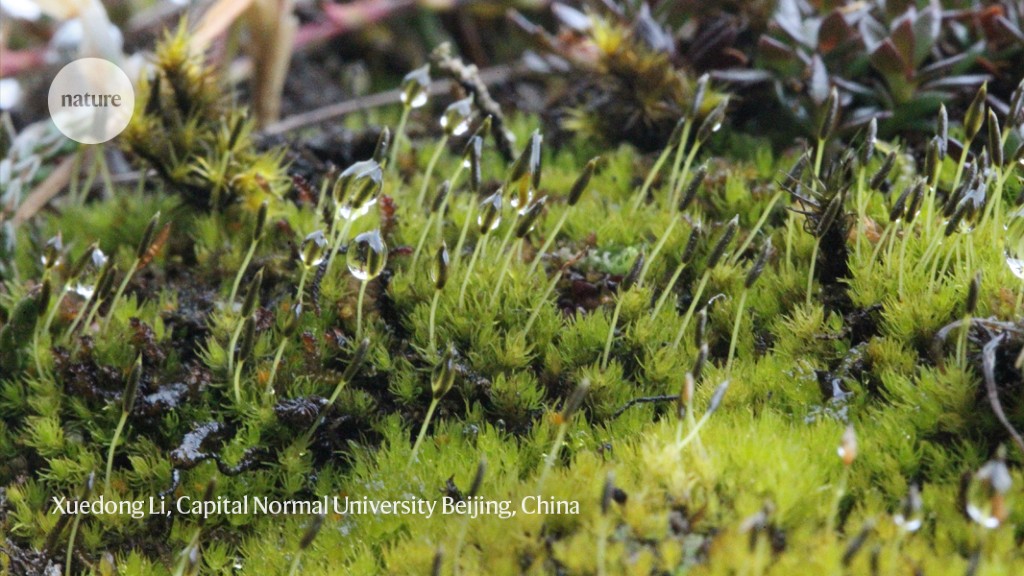This moss survived 165 million years — and now it's under threat from climate change

Ancient plant survived the formation of the Himalayas, but might now be facing extinction

Takakia mosses are seemingly unchanged externally for 165 million years, but paradoxically have a genome with a record number of fast-evolving genes.Credit: Xuedong Li, Capital Normal University Beijing, China
Beneath the feet of dinosaurs 165 million years ago, a green fuzz of mossy vegetation was surviving the crush. As the Indian landmass began to slam into Asia 65 million years ago, eventually thrusting the Himalayas into existence, the plants rode along to the rooftop of the world, adapting to their new frozen, sunny environment. But this genus of land plants, thought to be among the oldest living on Earth, is now in decline, probably caused in part by climate change.
“Everyone talks about dinosaurs and gets excited about dinosaurs,” says Ralf Reski, a plant biotechnologist at the University of Freiburg in Germany. “But these mosses have seen the dinosaurs come and go.”
The nearly 400-million-year-old genus, Takakia, comprises two species: T. ceratophylla and T. lepidozioides, which are found growing together only on the Tibetan plateau. Each species also lives without the other in a handful of places, including Alaska and British Columbia, although how they got there is a mystery. Reski and his colleagues spent a decade hiking in parts of the Himalayas at altitudes above 4,000 metres to learn the secrets of this unusual plant.
Rapid evolver
Bryophytes are a group of plants encompassing mosses, liverworts and hornworts, and previous researchers weren’t even sure which kind of bryophyte Takakia was. But the newly sequenced genome of T. lepidozioides, reported today in Cell1, confirms other work showing that Takakia is a rare moss. The species also boasts the highest number of fast-evolving genes on record for a plant.
Aided by a 165-million-year-old Takakia spp. fossil from Mongolia, Reski and a team of researchers combined data on the shape of T. lepidozioides and on its genome to reconstruct the moss’s evolution. Takakia is unique because on the outside, it has characteristics of earlier land plants, seemingly unchanged since it was fossilized. For example, its leaves lack the distinct topside and underside that plants have today. They also lack stomata, the leaf structure that most plants use to ‘breathe’.
But on the inside, the authors identified 121 genes that have evolved especially rapidly since then — some of which help it to survive in an extreme environment. The gene sequences contain a high number of mutations that lead to new protein variants, relative to mutations that do not alter the protein sequence. That’s twice the number of fast-evolving genes than in another Tibetan moss (Herbertus sendtenri).
The researchers think that, as the elevation of Takakia’s habitat rose around 50 million years ago when the Himalayan range began to uplift, the landscape became exposed to more ultraviolet radiation, lower temperatures and more snow — so the tiny moss had to adapt. One adaptation the plant has is a higher amount of lipids in its cells than other mosses, which helps it to resist the harmful rays of the Sun.
“Having the whole genome really lets you get into the gene evolution,” says Brent Mishler, a bryologist at the University of California, Berkeley. Whole-genome sequences exist for only a few other mosses. “It was really needed.”
Climate concerns
But the researchers also found evidence that Takakia is in trouble. Over the past decade on the Tibetan plateau, populations of the moss declined by 1.6% annually, faster than other local mosses; the International Union for Conservation of Nature’s Red List of Threatened Species classifies T. ceratophylla as globally vulnerable. Highly specialized organisms such as Takakia that have evolved to thrive in specific niches are poised to suffer more than other organisms as climate change alters habitat, Reski says. Takakia’s decline correlates with a temperature increase of almost 0.5 °C per year between 2010 and 2021.
But temperature might not be the sole cause of the plant’s decline, says Lalita Calabria, a bryologist at the Evergreen State College in Olympia, Washington. Bryophytes are sensitive to other environmental changes, such as air quality and humidity. Reski agrees that a limitation of the study is that the researchers do not yet know exactly why Takakia is in decline.
The ancient genome is a historical genetic manuscript of sorts, Mishler says, and it’s good to have a record in case T. lepidozioides goes extinct. Now, the genome can be used to help unravel more about the evolutionary history of mosses, and act as a record of its deep genetic diversity.
In the future, Reski and his colleagues would like to work with Takakia populations outside the Tibetan plateau to understand more about its adaptations so they can formulate conservation plans. “Because the species is so rare and has limited dispersal abilities, it’s really helping to make a more convincing argument for the protection of the species,” Calabria says.
doi: https://doi.org/10.1038/d41586-023-02514-8
This story originally appeared on: Nature - Author:Jude Coleman


















